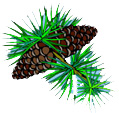5:
Fire
 To
survive fire some plants have adaptive traits that allow them
to reproduce or regenerate.
An
adaptive trait is a behaviour, physical feature or some other
characteristic that helps a plant or animal survive and make the
most of its habitat.
To
survive fire some plants have adaptive traits that allow them
to reproduce or regenerate.
An
adaptive trait is a behaviour, physical feature or some other
characteristic that helps a plant or animal survive and make the
most of its habitat.
When fire occurs, animals have the ability to fly, run away or
burrow deep into the ground. Plants cannot do this and so have
adapted other ways of surviving.
The way a plant stores its seeds and disperses them is an example
of a fire adaptive strategy. The intensity of the fire ( it is
important the fire reaches the right temperature) is crucial to
the seeds dispersal. Also important is how often the fires occur.
A number of species of pine have cones that only open after a
fire. These are called serotinus.
 Jack
pines have cones that are held closed by a resin sensitive to
high temperatures. These cones will not open to release their
seeds until a critical temperature is reached.
Jack
pines have cones that are held closed by a resin sensitive to
high temperatures. These cones will not open to release their
seeds until a critical temperature is reached.
Another type of pine called Lodgepole pine ( this is a western
U.S. variety of tree) is both serotinus and free opening.
This means that when this pine grows in an area where there are
frequent fires, the cones are serotinus, but when it grows in
an area where fires are less frequent, the cones open and release
the seeds without the need for fire.
Plants in the Australian bush are very reliant on fire. Although
some plants are killed off when a fire becomes extremely fierce
and hot ( high intensity), this heat triggers the seed dispersal
mechanism.
Some
plants may not come into flower for many years and if the fires
are too frequent, the plant is destroyed before it has had the
chance to produce seeds.
In
some cases if fires are frequent and do not reach the correct
temperature, the species will be killed and the seeds not dispersed
( the right heat is crucial to the seeds dispersal mechanism).
An example is a plant called Old Man Baksia. This plant is killed
by fire but uses the fire to trigger seed dispersal. However,
it takes about 15 years for this plant to reach flowering age.
A low intensity fire will kill it without triggering germination.
If a fire is high intensity but frequent, the plant dies without
seed dispersal.
Some species store their seeds in the soil until a fire reaches
the right heat for germination to be triggered. Again if the fires
are low intensity the parent plant may die but germination not
triggered. Fires are often deliberately lit in the bush to trigger
germination from soil seed banks and to kill weeds.
Unfortunately,
sometimes these fires get out of control and cause major damage.


